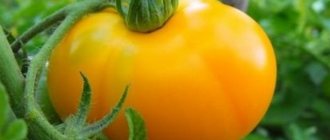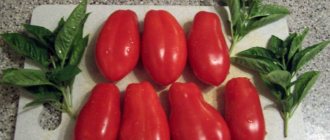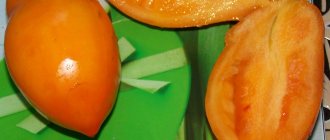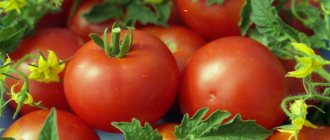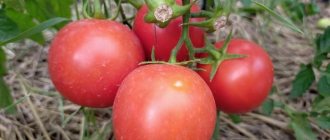| Ripening period: | mid-season (117-122 days from sowing) |
| Shape, weight of fruits: | spherical, weighing 100 g |
| Bush type: | semi-determinate, standard, height 120-160 cm |
| Growing regions: | the entire territory of Russia, in the northern regions - only closed ground |
| Productivity: | up to 6 kg per plant |
For vegetable growers who value high yield in tomatoes, unpretentiousness and versatility in using the crop, the Full tomato will be an excellent choice. This variety can be grown in open ground and in greenhouses.
Description and characteristics of the variety
Producers of seeds of this variety are the companies Aelita and Sadok. It is intended for personal subsidiary and small-scale farms.
Outdoor cultivation is recommended for the southern regions. Starting from the latitude of the Samara region, plants are placed in greenhouses or greenhouses.
Characteristics and description of the variety Full:
- The tomato is medium-sized, medium-branched. In open ground the height is 100-120 cm, in a greenhouse - up to 160 cm. The foliage and rate of formation of stepsons is average. The internodes are shortened, due to which the number of tassels on the stem reaches 10. Although the bush is powerful (standard), it requires garter to a support. Without it, the tomato may break under the weight of the brushes.
- The Fully tomato has an underdeveloped root system. This feature must be taken into account when creating a schedule for fertilizing and watering plants. Tomatoes need a regular supply of moisture and nutrition; they do not tolerate drought well.
- The first flower cluster is laid after the 7th leaf, the next ones - with an interval of 2 leaves. There are up to 7 fruits in a brush.
- Tomatoes are regular spherical in shape, without ribbing, with smooth skin. The color of a ripe tomato is bright red. The weight of tomatoes on the lower clusters can reach 180 g, their shape is closer to flat-round. The bulk of the fruit weighs 100 g. The tomato peel is strong, but not thick. During the ripening process, the fruits do not crack and are stored well. The taste of tomatoes is rich, sweet and sour. The pulp is tender, but dense, with a pronounced odor.
Tomatoes are delicious fresh and ideal for whole-fruit canning.
Under favorable weather conditions and proper care, up to 12 kg of tomatoes can be harvested from one square meter of tomato bed.
From the presented photos you can evaluate the appearance of the plant.
Tomato Full-Full
Tomatoes with fruits forming clusters, of the “full-full” variety, are meant for growing in the fresh air and in greenhouses or greenhouses. This variety of “full-full” tomatoes is distinguished by a large yield, excellent taste, and all sorts of options for use in the culinary field.
Advantages of this variety of tomatoes
The description and characteristics of this variety of tomatoes of the “full - full” variety classify the herbaceous tomato in the truss group. During the growing season, a shrub one hundred and twenty centimeters tall is formed. The root system is poorly developed, herbaceous with ordinary shoots, strongly growing leaves and reduced space between the nodes.
The first brush with the presence of peduncles is formed in part with the sixth - seventh leaf, and the next ones are formed at intervals every two. The herbaceous plant requires sufficient sunlight and is recommended for cultivation in the open air and in greenhouses or hotbeds.
Tomatoes of the “full-full” variety begin to bear fruit three to three and a half months after the day of seedling formation. A round tomato weighs ninety to one hundred grams.
The amount of harvest per square meter reaches thirteen to fifteen kilograms. Tomatoes, as can be seen in photographs on the Internet, have a shiny shell, it has a bright reddish color. The fruits differ in their compacted shell, amazing taste and fresh smell. In the culinary field, tomatoes are used raw, for making tomato juices, and also for canning.
Instructions for caring and growing this variety of tomatoes
Tomatoes are cultivated using seedlings, as you can see in videos on the Internet. Planting material is planted in the first weeks of the first spring month. For planting, use containers or any other containers with prepared and moist soil in advance. Until the seedlings peck, a thick film is placed on top.
The joint formation of seedling material is carried out by the method of advance treatment of planting material with a preparation containing potassium permanganate and water. To ensure good tomato development, it is necessary to increase the duration of daylight hours using additional artificial light; you can purchase a fluorescent lamp.
At the stage of formation of one full leaf, diving is carried out, or the plants are moved into separate pots or any other containers. Two to two and a half months after the seedlings peck, the seedlings are moved to a permanent site for further growth. Immediately before planting in the soil, the herbaceous plant must be hardened to ensure adaptation to new factors without causing any harm.
To ensure a large amount of herbaceous harvest, it is recommended to plant three to four representatives of herbaceous crops per square meter. During the growing season, it is necessary to constantly moisten and apply fertilizers, for example, complex ones.
The characteristics of the tomato draw attention to the possibility of increasing the amount of plant yield by forming a single or double stem. At the time of cultivation, it is recommended to tie the herbaceous plant to pegs and additional sticks
To maintain a normal amount of liquid and oxygen near the root system, timely loosening of the soil next to the bush is carried out. To simplify the fight against weeds, a layer of mulch is made on the soil from sawdust, grasses and special dark fiber.
Herbaceous plants usually do not have immunity to attacks from parasites - insects. This means you need to take advice, carry out preventive procedures and thoroughly examine the bushes.
Features of cultivation and care
The sowing time for the Full variety is determined by the climate of the area and the method of cultivation. By the time seedlings are planted in the ground, their age should be 60-65 days. Taking into account the germination time of seeds (about a week), the crop is sown 70-74 days before placement on the garden bed.
Tomatoes are placed in open ground when the air temperature at night does not drop below +12 degrees. The optimal temperature for the plant is +18 +22 degrees.
In the climate of the middle zone, seedlings are planted in late May - early June. In the south, tomatoes are planted in the garden in early May.
Tomatoes are heat-loving plants that do not tolerate negative temperatures. If there is a threat of frost, bushes planted in the ground are covered with film, non-woven material, and covered with straw.
Seedlings are planted indoors 10-15 days earlier than outside. The planting pattern is 40 by 50 cm. The bushes are immediately tied up using stakes or a trellis as a support.
Growing in open ground
Caring for plantings involves regular feeding, watering and removing shoots from the plant.
It is necessary to remember about poorly developed tomato roots. It is necessary to water the bushes in small portions, at least once every 3 days.
Mulching the surface of the soil around the bushes with straw, bark or mown grass will help prevent the soil from drying out.
Tomatoes are fed every 2 weeks, starting from the moment of planting. Watering with nutrient solutions under the roots alternates with spraying the crown with preparations for foliar feeding.
Infusions of mullein manure (in the first half of the growing season) and ready-made mineral mixtures for tomatoes are used as fertilizers. Adherents of organic farming use eggshells, banana peels, iodine, ammonia, and weed infusion to feed tomatoes.
Tomato variety Full Full is grown in 1-2 stems. The second stem is formed from the lower strong stepson, the remaining shoots are removed until they reach a length of 5 cm.
When grown in open ground, the growth of the bush is limited to a height of 100-120 cm, pinching the top. In order for the fruits to ripen on the bush, in mid-August all flowers and ovaries smaller than hazelnuts are removed from the plant. In the greenhouse, tomatoes are allowed to grow freely upward; the number of ovaries is not standardized.
The harvest for storage is harvested at the stage of technical ripeness, when the tomato is colored pink.
Tomatoes can be stored for up to 3 weeks in a cool, dark place.
Tomato Big Momma
An early maturing tomato hybrid of Russian selection for open ground.
Ripening period is 85-95 days. Productivity 3-4 kg per plant.
The fruits are heart-shaped, slightly ribbed, bright red, large (weighing 200-350 g). The pulp is richly sweet, tasty, dense, fleshy, with a high content of dry matter. The purpose is universal. Transportability is excellent.
From the reviews of summer residents: “early, determinate, low-growing - just what you need”, “for those who are tired of the jungle, it’s a super plus: you can grow it both in open ground and in a greenhouse”, “the bushes are neat, the fruits do not crack” , “beautiful, smooth, you wouldn’t be ashamed to treat your neighbors to these tomatoes!”, “pulp with a rich sweet taste and a high content of nutrients and lycopene!”
Diseases and pests
Fully tomatoes do not have genetic resistance to diseases and pests, so the gardener needs to pay attention to disease prevention.
Immediately after placing the plants in the garden bed, spray with Fitosporin, Trichodermin or another antifungal drug. In damp and cool summers, treatments are done every 2 weeks. A safe and effective remedy is an aqueous solution of whey and garlic infusion.
Weeding and timely removal of shoots and lower old leaves help improve the ventilation of tomatoes and reduce the risk of developing fungal diseases.
Against pests, tomatoes are sprayed for preventive purposes with an infusion of ash, garlic, tobacco, and wormwood. If insects are present, use Aktaru and Inta Vir.
Error in greenhouse structure
As a rule, cheap transparent houses for plants are not equipped with windows, or an exhaust hood, or heating. In such a “steam chamber”, where air humidity sometimes reaches 100%, and temperature fluctuations depend on its fluctuations outside, there is increased condensation flowing down the walls and dripping on exhausted bushes, does not at all contribute to the development of “best” tomatoes in the greenhouse, but actively promotes the development of “excellent” late blight.
Exceeding the temperature regime is detrimental not only to plants, but also to their pollen. “Overcooked” or wet pollen becomes sterile.
Trying to get a harvest of nightshades of unprecedented size, new owners of greenhouses plant all available spaces as densely as possible with all types of nightshades in a row. This cannot be done!
In the thickened wilds of various vines and bushes, not only late blight readily reproduces, but also other fungal diseases, for example, powdery mildew or the scourge of any plant grown in a greenhouse - black leg. The spider mite won't keep you waiting either! High humidity and high temperature are optimal conditions for the reproduction of this parasite.
What to do if the house for “tomatoes” is already standing, but there is no harvest of thick-cheeked nightshades in it?
- We insert windows or vents, cut in a second door if there is none, and regularly ventilate the room and seedlings
- We change the soil. In no case do we introduce fresh manure into fresh manure.
- We treat the entire house with a disinfectant solution
- Monitor humidity and temperature
- During the development of seedlings, humidity is from 60% to 70. Fruiting is from 75 to 85%
- Soil humidity is not higher than 80%, temperature is not less than 12-15*
- The air temperature should not rise above 25-28*
- We follow the landing pattern
- We plant low-growing “early ripening” from 2 stems at a distance of 40 cm from each other, 55-60 cm between rows
- Vigorous tomatoes with 1 stem - 25-30 cm apart
The Summer Resident tomato can be grown without preparing seedlings, especially in the recommended North Caucasus region. Seeds sown directly into the garden bed with the onset of warm weather or under temporary shelter will sprout perfectly, and after the required 3.5 months it will be possible to harvest ripe tomatoes. But in regions that are not the warmest, this approach will allow you to harvest only in August, when you no longer really want tomatoes that don’t have the most exquisite taste. Therefore, in most areas, Dacha is grown through the seedling stage.
Seedlings of this tomato are easy to obtain; you should not sow the seeds too early. After all, seedlings can be planted in a garden bed only at the onset of summer, but for a summer resident they are ready for planting already at the age of one and a half months. By two months the bushes are already beginning to bloom. But the small growth of tomatoes makes it easier to install temporary shelters, which is often used to obtain an earlier harvest. Under this condition, in the middle zone, planting seedlings is possible as early as May 10–15, which means that seeds can be sown in boxes in mid-March.
No pots are required to grow Summer Resident seedlings: stocky plants grow well in a common box
The fruits of the Summer Resident tomato mostly have time to ripen on the bushes; there is no need to pick them unripe: this is done only in the fall, before frost, but by then only a few specimens remain in the beds.
Advantages and disadvantages
Numerous reviews from gardeners growing the Fully tomato reveal the following advantages of the variety:
high yield, regardless of the growing method;
excellent taste of fruits;
uniformity of tomatoes in size;
versatility of crop use.
The downside is the weakness of the roots, forcing the vegetable grower to provide the plant with constant care. The variety Full is not one of those tomatoes that can be planted in the garden and “forgot” until harvest time.
Early (early ripening) and mid-early
In fact, no one ignored the hybrids of very early tomatoes with poetic names
Variety Nadezhda F1
Variety Aphrodite F1
https://www.youtube.com/watch?v=O3D1P75Z6ig
Very good reviews from gardeners!
Intuition F1
According to reviews, the taste of the fruit is above average, and the keeping quality is even higher. Tomatoes of a regular round shape hold tightly to the hand and do not crack when overripe.
Cio-Cio-san
“These tomatoes are for those who cannot imagine a good lunch without a tomato salad and for those who cannot imagine a winter table without pickled tomatoes! So you definitely need to grow these tomatoes, but you also need to get a greenhouse for this purpose! Eating these tomatoes fresh and as winter marinades is a pleasure! They are simply convenient and delicious to eat!”
Kolkhozny
“The collective farmer is just smart! It grew practically without watering or care, and gave very good results! I even overcame late blight! The fruits are delicious! Now, at the end of the season, I understand that if I had looked after it with all the zeal, the harvest would have been larger and the tomatoes would have been even tastier!”
- American ribbed
- Mushroom basket
- Etoile
- Lorraine handsome
- White-fruited
- Snow White
- White miracle
- Aronia
- Black Prince
- Mikado
- Rio Negro
- Dallas Roses
- Raj Kapoor
- Gypsy
Similar varieties
The following varieties and hybrids of tomatoes have similar characteristics to Full Full:
- Chaika (early, height 70 cm, red fruits, weighing 100 g);
- Volgogradsky 595 (medium late, height 100 cm, red tomatoes, weighing 100-150 g);
- Fighter (early ripening, height up to 150 cm, red fruits, weighing 150 g);
- Bobcat tomato (medium late, height up to 120 cm, flat-round tomatoes, weighing 100-170 g);
- Andromeda (early, height 70 cm, fruit weight 120 g).
A number of hybrid tall tomatoes (Barika, Verlioka, Evpator F1) form a harvest of small, dense fruits suitable for canning.
Tomato Explosion
An early maturing tomato variety of Russian selection (created on the basis of the variety) for open ground.
The bush is determinate, low-growing (up to 50-60 cm in height), requires tying to a support and moderate pinching. The leaves are light green, medium in size, the foliage of the bush is average. The plant is unpretentious, characterized by increased drought and cold resistance, resistance to late blight and root rot.
Can be grown without seedlings. Fruit ripening period is 90-100 days from emergence. Productivity 2-4 kg per plant.
From the reviews of summer residents: “they grow very well, and the harvest exceeds all expectations”, “juicy, they ripen well, they are stored for a month and a half”, “they set before all other varieties”, “they ripen perfectly, even if you don’t spoil them with fertilizing”, “they gain weight really at explosive speed!”



